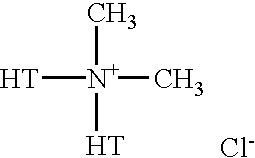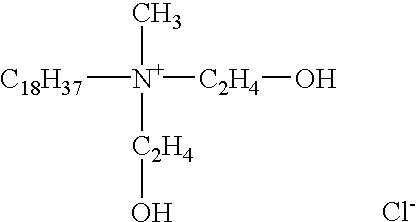Preparation of polymer nanocomposites by dispersion destabilization
a technology of dispersion destabilization and polymer nanocomposite, which is applied in the field of polymer nanocomposite, can solve the problems of preparing nanocomposites, incorporating clay minerals in polymer matrix, and not always being a straightforward process,
- Summary
- Abstract
- Description
- Claims
- Application Information
AI Technical Summary
Problems solved by technology
Method used
Image
Examples
example 1
To 100 g of an approximately 50% solids by weight of Good-Rite SB-0738 (a latex polymer available from B. F. Goodrich), was added, with stirring, 100 g of a 3.06% by weight aqueous clay slurry of Cloisite® (Southern Clay Products). To the stirred mixture was added 4.8 grams of hydrogenated tallow alkyl(2-ethylhexyl)dimethyl ammonium methylsulfate, (Arquad ® HTL8-MS, Akzo Chemical). The dispersion mixture flocculated, was separated from the water by filtration and the solids were dried in an oven at about 50° C. An x-ray diffraction analysis of the formed nanocomposite was run. The D001 peak was absent indicating high exfoliation of the clay material in the polymer.
example 2
Example 2 was conducted as Example 1 except that Good-Rite SB-1168 (a latex polymer available from B. F. Goodrich) was utilized. The dispersion mixture flocculated. The D001 peak was present and indicated smectite clay platelet spacing of about 36 Å.
example 3
Example 3 was conducted as Example 1 except that Good-Rite SB-1177 (a latex polymer available from B. F. Goodrich) was utilized. The dispersion mixture flocculated. The D001 peak was present and indicated smectite clay platelet spacing of about 38 Å.
PUM
| Property | Measurement | Unit |
|---|---|---|
| Fraction | aaaaa | aaaaa |
| Percent by mass | aaaaa | aaaaa |
| Percent by mass | aaaaa | aaaaa |
Abstract
Description
Claims
Application Information
 Login to View More
Login to View More - R&D
- Intellectual Property
- Life Sciences
- Materials
- Tech Scout
- Unparalleled Data Quality
- Higher Quality Content
- 60% Fewer Hallucinations
Browse by: Latest US Patents, China's latest patents, Technical Efficacy Thesaurus, Application Domain, Technology Topic, Popular Technical Reports.
© 2025 PatSnap. All rights reserved.Legal|Privacy policy|Modern Slavery Act Transparency Statement|Sitemap|About US| Contact US: help@patsnap.com



